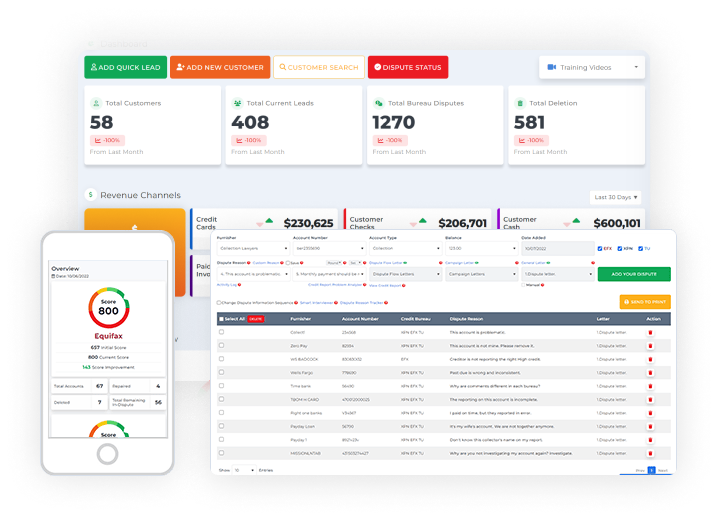Credit scores significantly impact our financial decisions and opportunities. Fixing errors on a credit report, known as credit repair, is essential to maintaining a good financial standing. In the past, many sought expert help for this, but the rise of DIY credit repair software has changed the game. Tools like the Client Dispute Manager’s credit repair software make this process simpler and more accessible. This guide will help you understand the benefits and functionalities of such software, empowering you to take control of your credit journey.
What is DIY Credit Repair Software?
DIY credit repair software is a cutting-edge tool designed for individuals seeking to take control of their financial health by addressing inaccuracies, discrepancies, or negative items on their credit reports without relying on professional credit repair agencies. Put simply, this software empowers users to take a “Do It Yourself” approach towards enhancing their credit score. If you’re wondering about the cost-effectiveness of such solutions, you might be interested in exploring free credit repair software options.
How A DIY Credit Repair Software Works?

At its core, DIY credit repair software like Client Dispute Manager offers a user-friendly interface and features tailored to facilitate the credit repair process. Here’s a general walkthrough of its functionalities and capabilities:
Credit Report Importation
Most of these software solutions empower users by offering seamless integration capabilities, enabling them to easily import their credit reports from the major credit bureaus such as Equifax, Experian, and TransUnion. Once imported, these programs provide sophisticated analytical tools that sift through the myriad of data points on each report.
This comprehensive analysis aids in highlighting discrepancies and inconsistencies, which could range from misreported financial transactions, mistaken identities, or outdated account statuses. The software’s intuitive design and detailed report breakdowns make it simpler for users to pinpoint potential errors, outdated information, or other areas that may be negatively impacting their credit scores.
This proactive identification is pivotal as even minor inaccuracies can have a significant effect on one’s financial credibility and borrowing power. Armed with this detailed insight, users are better positioned to take corrective measures and ensure the accuracy of their credit profiles.
Dispute Management
The primary strength of credit repair software lies in its ability to create, manage, and organize dispute letters, essential tools in the credit repair process. These software solutions come equipped with a variety of templates suited for different types of discrepancies or issues that might appear on credit reports.
These templates are designed to be flexible. Users are given the freedom to adapt and modify them to suit their specific concerns with precision. This adaptability enables a personalized approach to credit repair, ensuring that communication with credit bureaus is both targeted and effective.
Furthermore, quality credit repair software offers a comprehensive system to monitor sent disputes, follow up on pending issues, and manage responses from the bureaus. This all-encompassing method not only helps users articulate their concerns effectively but also increases their odds of correcting inaccuracies and enhancing their credit scores.
Track Progress
As the DIY credit repair journey progresses, users will find that one of the most empowering features of DIY credit repair software is its ability to provide real-time feedback. When disputes are submitted, users aren’t left in the dark.
As resolutions are achieved, whether they result in the removal of a negative item or an update to an account status, DIY credit repair software allows users to witness firsthand the improvements in their credit score. This isn’t just about numbers; it’s about witnessing the tangible benefits of their efforts.
Moreover, the sophisticated tracking capabilities of DIY credit repair software play a pivotal role. They not only keep users apprised of the status of each dispute in real-time but also offer detailed insights into any changes or updates in their credit report.
This ensures that users are not just passive observers but active participants, always informed and always in control. With DIY credit repair software, users are equipped with the tools to continuously gauge their progress and stay motivated throughout their credit repair journey.
Educational Resources
Navigating the intricacies of credit can be overwhelming. Many DIY credit repair software solutions emphasize user education. Apart from their core functionalities to address credit report discrepancies, these platforms provide extensive guides, tips, and tutorials to clarify credit concepts.
By blending practical tools with educational resources, this software empowers users to both manage and understand their credit, ensuring informed decision-making throughout their credit repair journey. If you’re weighing the pros and cons of using software versus hiring professionals, you might find this comparison of credit repair software vs hiring a credit repair agency insightful.
Security
Protecting users’ sensitive financial data is paramount, especially in DIY credit repair software. Advanced encryption techniques ensure that information remains secure and unreadable to potential intruders. Two-factor authentication amplifies this security, necessitating a secondary verification step beyond just a password.
Moreover, regular data backups within the DIY credit repair software ensure against data loss, enabling prompt restoration if needed. Collectively, these robust security features offer users peace of mind and confidence when using DIY credit repair software to manage their critical financial data.
Benefits of Using DIY Credit Repair Software

In the ever-evolving landscape of personal finance management, DIY credit repair software stands out as an innovative solution for those aiming to optimize their credit profiles. Among the available options, Client Dispute Manager software exemplifies the gold standard in this domain. Let’s delve into the tangible benefits that such software provides, with a spotlight on the advantages of choosing Client Dispute Manager:
Cost-Effective
Using DIY credit repair software can be cost-effective. Instead of paying ongoing fees for professional services, users can achieve considerable financial savings. Such software typically provides a comprehensive suite of features, allowing users to enjoy high-quality services without the high costs.
Privacy
In an era where data privacy is of utmost importance, opting for the DIY approach helps ensure that personal and financial information remains secure. Many DIY platforms emphasize user privacy, allowing individuals to diligently repair their credit without the risk of unsolicited data sharing or external interferences.
User-Friendly Interface
A prevalent myth is that credit repair demands intricate technical knowledge. However, many top-tier credit repair software solutions are designed with user-friendliness in mind. They cater to a wide range of users, from beginners to experts, guaranteeing a smooth and user-focused experience.
Control
The core principle of DIY is empowerment and autonomy. With DIY credit repair software, users take charge of their own credit repair journey. Such tools provide a platform that allows users to customize their strategies, pace, and focal areas. This degree of control ensures that the process aligns perfectly with individual goals and preferences.
Features to Look for in a Good DIY Credit Repair Software

The digital frontier of credit repair has introduced numerous software solutions designed to empower individuals in their quest for optimal credit scores. However, to truly harness the potential of DIY credit repair software, it’s essential to discern which features make a platform stand out from the crowd. Client Dispute Manager software is a stellar example that incorporates these indispensable features:
Automated Dispute Generation
Central to the credit repair process is the ability to effectively communicate discrepancies and issues. An exceptional DIY credit repair software should provide automated tools for drafting and dispatching dispute letters. Client Dispute Manager, for instance, offers a streamlined mechanism, ensuring that users can address each concern with precision and professionalism.
Credit Score Tracker
Monitoring progress is pivotal. As users work diligently to enhance their credit profiles, they should have at their disposal a real-time credit score tracker. This feature, exemplified by platforms like Client Dispute Manager, allows individuals to witness firsthand the tangible results of their efforts, maintaining motivation and clarity throughout the process.
Integration with Credit Bureaus
In an interconnected digital ecosystem, the ability to seamlessly interact with major credit bureaus is a hallmark of top-tier DIY credit repair software. This integration facilitates the effortless importation and updating of credit reports, making the entire process more efficient. Client Dispute Manager’s adept integration capabilities ensure that users have the most current and accurate data to work with.
Guided Workflows
Venturing into the domain of credit repair can be daunting for many. This is where guided workflows come into play. A software solution should offer step-by-step processes, demystifying the journey and ensuring that users remain on the right trajectory. With Client Dispute Manager‘s intuitive design, users are systematically guided, ensuring each action aligns with best practices in credit repair.
For a deeper dive into the essential components of top-tier credit repair platforms, consider exploring this comprehensive guide on main features of credit repair software. In essence, when evaluating DIY credit repair software, it’s paramount to prioritize platforms that offer a blend of functionality, guidance, and education. Client Dispute Manager software, with its comprehensive suite of features, exemplifies what users should seek when venturing into the realm of self-directed credit repair.
Conclusion
As we’ve journeyed through this comprehensive guide, it’s evident that these tools offer individuals the means to address, amend, and enhance their credit profiles, all while ensuring privacy, cost-efficiency, and personalized pacing. With software like Client Dispute Manager leading the charge, the barriers that once existed between individuals and their optimal credit scores are being steadily dismantled.
As we wrap up, the message is clear: you hold the key to unlocking your financial potential. By leveraging the prowess of sophisticated credit repair tools, a brighter financial horizon awaits. Equip yourself, stay informed, and embrace the power of DIY in your credit repair journey.
Bonus: Now that you have read this article, why not take your new skill and start your own credit business helping others? We have free training that can help you do just that.
Click here to learn more.


